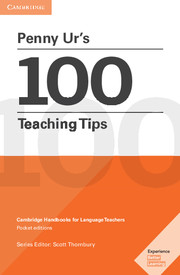Book contents
- Frontmatter
- Contents
- Why I Wrote this Book
- Beginning and Ending the Lesson
- The Coursebook
- Discipline
- Error Correction
- Games
- Grammar
- Group Work
- Heterogeneous (Mixed-Level) Classes
- Homework
- Interest
- Listening
- Pronunciation
- Reading Comprehension
- Speaking Activities
- Teacher Talk
- Testing and Assessment
- Vocabulary Teaching
- Writing
- P.S.
- Index
- Photo Acknowledgements
Writing
Published online by Cambridge University Press: 17 November 2023
- Frontmatter
- Contents
- Why I Wrote this Book
- Beginning and Ending the Lesson
- The Coursebook
- Discipline
- Error Correction
- Games
- Grammar
- Group Work
- Heterogeneous (Mixed-Level) Classes
- Homework
- Interest
- Listening
- Pronunciation
- Reading Comprehension
- Speaking Activities
- Teacher Talk
- Testing and Assessment
- Vocabulary Teaching
- Writing
- P.S.
- Index
- Photo Acknowledgements
Summary
Writing has become a much more important skill in recent years owing to the increase in the use of digital communications like email, SMS, blogging and so on. So we need to enable our students to compose not only formal prose but also informal messages – and to be aware of the differences.
94 Use copying tasks for beginners
95 Do writing in class
96 Teach spelling rules
97 Encourage typing
98 Get students to rewrite
99 Use SMS texting
94 Use copying tasks for beginners
For beginner learners whose own language does not use the Latin script, copying can be a very useful activity, provided they know the sounds or meanings of what they are copying.
Handwriting will continue to be important for the foreseeable future, in spite of the growing use of computer keyboards. Beginner students need to learn how to write the letters themselves: a challenge particularly for those whose mother tongue does not use the Latin alphabet, and may not even be read from left to right.
Having been taught the shapes and sounds of the letters, students need practice in writing them. At this stage, copying tasks are useful because they give this practice, while freeing the writer of the need to retrieve the new forms entirely from memory. However, copying tasks can be boring, and there's not much point being able to draw a letter if you don't know what it sounds like! So the tasks should be designed to require at least knowledge of the sound, if not meaning, of what is being copied.
Some possible tasks are the following:
• Students copy each letter and write next to it the mother-tongue letter that sounds similar.
• There is a set of letters or words on the board and students copy down the ones the teacher says.
• There is a set of letters (e.g. b, a, l, c, h) next to a picture representing a known word (e.g. a drawing of an apple) and students copy only those letters whose sound appears in the word.
• There is a set of words next to a picture and students copy only those words that are relevant to the picture.
• Students copy a set of names of people and; write next to each m (if it's a male name) or f (if female).
• Students copy a word and draw a picture representing it.
- Type
- Chapter
- Information
- Penny Ur's 100 Teaching TipsCambridge Handbooks for Language Teachers, pp. 111 - 117Publisher: Cambridge University PressPrint publication year: 2016



